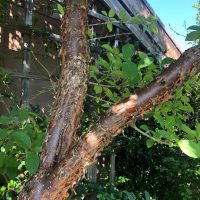A Spotlight on Memorials at the Washington Park Arboretum

Over the years, numerous memorials have been developed in the Arboretum, and several plant collections memorialize individuals. The following are some memorials, and a nearby plant.
1) Camellia japonica ‘Oridono-nishiki’ Foxworthy Benches
This memorial, composed of three benches in memory of Mary Hughes Foxworthy, was installed in 1961 along the trail traversing Rhododendron Glen above the Lookout Gazebo.
There are thousands of cultivars of Camellia japonica in cultivation, with many different colors and forms of flowers.
2019 John A. Wott Endowed Student Award Awarded to Kyra Matin

The John A. Wott Botanic Gardens Endowed Student Award was awarded this spring to Kyra Matin, a second-year Master of Environmental Horticulture student at the University of Washington School of Environmental and Forest Sciences.
As part of her masters project, Kyra is working on several aspects of the New Zealand Forest display in the Pacific Connections Garden at the Washington Park Arboretum.
A Deep Dive into Arboretum Plant Collections.

I created a new tool for serious plant geeks who want to learn everything they can about specific plants growing in the Washington Park Arboretum. Starting from one of three access points to our plant data, the Living Collection Search, the advanced Interactive Map, or the basic Interactive Map, people can search for a plant and discover if it is growing, and where, in the Arboretum.
Read moreLate Summer Cuttings from the Washington Park Arboretum

1) Castanea dentata American Chestnut
The American Chestnut, once an important and substantial member of the East Coast hardwood forests, is now all but extinct in the wild due to the chestnut blight that likely arrived from Japan in the 1890s.
Chestnuts are sweet and edible, though hidden inside a prickly burr.
Blight resistant cultivars are still being developed in order to bring back this majestic tree.
A UW Farm Internship Reflection

My Experience As A Member Of The Farm Team
Organic…All-Natural…non-GMO…no additives. So what do these all really mean? My summer as a graduate student farmworker has given me the opportunity to investigate this appetizing discussion frequently circling food communities and connoisseurs. Now I am far from claiming myself a food guru, but my time so far on the UW Farm has opened tremendous insight on the day-to-day experience of an urban farmer.
Read moreSummer Beauty at the Washington Park Arboretum

1) Lagerstroemia indica ‘Muskogee’ Crapemyrtle
Crapemyrtles are beautiful late summer flowering trees with attractive mottled and smooth bark.
This genus has long been popular in southern gardens and is gaining popularity in our urban environment.
This tree can be enjoyed a short walk down Azalea Way from the Graham Visitors Center.
2) Leptospermum lanigerum Wooly Tea-Tree
This common Australian small tree or bush can be found in our Australian collections near the southern end of Arboretum Drive.
Read moreStaff Profile: Duke Clinch

From Football to Farming
This is Duke’s first year as one of three UW Farm student staff. Originally from Woodinville, WA, Duke was on the University of Washington football team his freshman year. During that first season as a Husky, he sustained a back injury that ended his playing career. However, he continues to be connected to the team, working as part of the UW Football film crew that tapes games and practices.
Read moreAugust 2019 Plant Profile: Ornamental Oregano

Grown for their delicate showy flowers rather than pungent leaves, the ornamental oreganos deserve a place in Pacific Northwest gardens.
Read moreRubus: Berries and Brambles found throughout the Arboretum

1) Rubus armeniacus, Himalayan blackberry
This notorious invasive species was introduced to Washington in the late 1800s for its delicious and prolific berries.
It is often found in disturbed areas and has adapted to wet, dry, sunny, and shady conditions.
2) Rubus leucodermis, blackcap raspberry
This species, native to the West Coast, is known for the dusty white/blue coating on older stems and its arching habit.
Read more